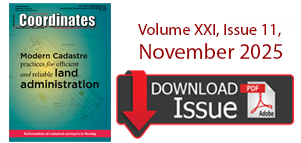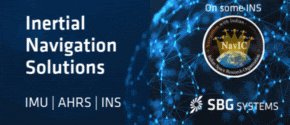
Update from the International System Providers Meeting (ICG-3)
At the third meeting of the International Committee on GNSS (ICG-3), a voluntary United Nations–backed association that brings together GNSS and augmentation providers, Paul Verhoef, head of the Galileo unit for the European Commission Directorate-General for Transport and Energy, said that the EU expects to have contracts for building the Galileo FOC system in place by next summer. He noted that the target date for completion is 2013 had been given to prospective vendors in the Galileo invitations to tender (ITTs). The European GNSS Supervisory Agency (GSA), which had been charged with overseeing development and operation of Galileo under the abandoned publicprivate partnership, will be given a different name next year to refl ect its altered responsibilities under the public procurement now led by the EC and the European Space Agency. www.geolinks.org/icg3/

JAXA joins UNESCO World Heritage Initiative
The Japan Aerospace Exploration Agency (JAXA) has joined a partnership with UNESCO, under which it will mobilise the Advanced Land Observing Satellite (ALOS) for the study and safeguarding of World Heritage sites. UNESCO member states, mainly in Asia, can now access JAXA technology for activities conducted as part of the Open Initiative on the Use of Space Technologies for World Heritage Sites. www.unesco.org

National Geo Data Regulatory Authority Bill
The 8th National Spatial Data Infrastructure (NSDI) meet was held at New Delhi during 22-23 Dec 2008. The meeting was organised by Ministry of Science and Technology in association with FICCI. The meeting was inaugurated by Union Minister for Science and Technology and Earth Sciences, Mr Kapil Sibal. In his address, Mr Sibal told the gathering the government was preparing a legislation on sharing of geospatial data amongst different agencies – public and private. A bill in this regard, National Geospatial Data Regulatory Authority Bill, is to be introduced in the next session of Parliament and is likely to be cleared by the Cabinet by February 2009. The inaugural session was also addressed by Dr K Kasturirangan, Member of Parliament and Dr T Ramasamy, Secretary, Department of Science and Technology. During the meet, the Indian Geo-portal was also launched.

Scanning the Heritage
In a unique project aimed at preserving the country’s rich heritage, the 16th century Humayun’s Tomb in New Delhi, India will become the first monument in the country to be measured to sub centimeter accuracy. Each stone will be measured using a high-density laser scan, colour images and 3D visualisation. Leica Geosystems High-Defi nition Survey (HDS) technology will assist archaeologists and conservationists in getting near accurate data and records of the entire Humayun’s Tomb complex within weeks. The technology developed by Leica Geosystems has been widely used at heritage sites across the globe, including the Blue Mosque in Turkey and Leaning Tower of Pisa in Italy. This project is being undertaken by the Aga Khan Trust for Culture as part of the ongoing partnership project with Archaeological Survey of India (ASI).
The process of HDS requires a 3D high defi nition laser scanner which scans the entire monument. While scanning depends on the size of the structure and takes only a few days’ time, documenting all the details can take a few weeks with 99% accuracy. This is a significant leap from the traditional method of using a measuring tape and other such tools which takes several months. According to offi cials, this technology will give the ASI an opportunity to document the 5,000 monuments in its charge in a short span of fi ve to six years.
Following are the excerpts of the interview conducted with Mr. Faheem Khan, Regional Segment Manager, GIS and Scanning, ISAK Region, Leica Geosystem about the HDS technology.
1. What are key the points about the procedure for scanning and documentation that will be used on the Humayun’s Tomb?
Leica Geosystems’ (HDS) High-Defi nition Surveying technology presents a quantum leap in technology offering users the ability to document sites and facilities, from crime scenes to oil platforms, in speeds, accuracy and quality that is not possible using traditional methods. This technology will allow site managers at Humayun’s Tomb to use the automatic data collection capabilities offered by the ScanStation and capture complete and accurate data in minutes and stream the results over the internet using the free and easy-to-use Leica TruView webpublishing solution.
2. How does ScanStation manage to give such high accuracies?
As indicated in various independent studies carried out around the world the Leica ScanStation features some of the lowest data noise levels and ultra-fi ne laser spot size in the industry. This coupled with our heritage in optics and distance measurement technology and manufacturing quality allow our customers to enjoy unprecedented quality and accuracies in measurement results.
3. What all other kind of application can a Scan Station is useful for?
The ScanStation is actively used by the Forensic community for anti-terrorist and forensic mapping activities. In addition, various engineering users deploy ScanStation to carry out accurate plant as-builts to support the design, installation, operations and documentation process. Mining users are also taking full advantage of the speed and completeness in which the data is captured to calculate accurate volumes, monitoring excavation and support in engineering efforts. Higher education community are today educating students across the departments – Civil Engineering, Geomatics, Geography etc. to train them in HDS technology.
One last example comes from the Survey fraternity where traditional topographic/civil survey is completed faster, cheaper and safer than traditional methods.
December 2008
GEOExpo 2008 China
2 – 4 December 2008,
Shanghai, China
sales@chinageo-expo.com
http://www.ChinaGeo-Expo.com
January 2009
ESRI Asia Pacific User Conference
20-21 January 2009
Singapore city,Singapore
http://www.esri.com/events/apuc/index.html
Intergeo East
27-29 January 2009
Istanbul,Turkey
http://www.intergeo-east.com
February 2009
Trimble Dimension 2009
123-25, February 2009
The Mirage, Las Vegas, USA
http://www.trimbleevents.com/dimensions09
March 2009
Munich Satellite Navigation Summit Conference
March 3-5,2009
Munich, Germany
http://www.munich-satellite-navigation-summit.org
April 2009
GEO Siberia 2009
21-23 April
Novosibirsk, Russian
nenash@sibfair.ru
http://www.geosiberia.sibfair.ru
May 2009
International Conference on …

In this article students from around the globe were canvassed on their views on their studies in geomatics and GNSS. Interesting commentaries and views were received from twelve students. There were a number of common threads that run through their views and these include the major challenges of costs of equipment and software, distinctions between geomatic education, training and research, beyond space, time…
Economic slowdown, meltdown, recession…
Cost cut, retrenchments, …
Fears, uncertainty, survival issue…
Is geomatics industry immune?
No, if we talk about banking, retail or auto segments…
To an extent yes, if we think about government-driven infrastructure projects.
Defence, internal security, …
Appears, we are heading towards diffi cult times.
It is also a time to correct fundamentals.
Focus on forgotten sectors like agriculture.
…

Signal design criteria and parametric analysis
F Zanier, M Crisci, M Luise
Voices of Future
George Cho,
Adam Yau, Chris Goodall, Deok Won Lim, Hedeki Yamada, Karla Edwards, Malambo Moonga Lonesome, Ruzinoor Che
Mat, Sheelan SH.Vaez, Simone Savasta, Suddhasheel Ghosh Susham Biswas, Thilantha Lakmal Dammalage, Xiaofan Li
Land record information system
Dr Aruns Saxena, Sanjeev Saxena And Akanksha Patil

Land Information Management System is defi ned as the combination of human and technical resources, together with a set of organizing procedures that produces information on land in support of a broad range of managerial requirements. Data are raw collection of facts. Data relating to land may be acquired and held in alphanumeric form (for example books), or graphically (for example, as maps or aerial photographs), or digitally…










 (5.00 out of 5)
(5.00 out of 5)